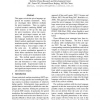Free Online Productivity Tools
i2Speak
i2Symbol
i2OCR
iTex2Img
iWeb2Print
iWeb2Shot
i2Type
iPdf2Split
iPdf2Merge
i2Bopomofo
i2Arabic
i2Style
i2Image
i2PDF
iLatex2Rtf
Sci2ools
ACL
2009
2009
Revisiting Pivot Language Approach for Machine Translation
This paper revisits the pivot language approach for machine translation. First, we investigate three different methods for pivot translation. Then we employ a hybrid method combining RBMT and SMT systems to fill up the data gap for pivot translation, where the sourcepivot and pivot-target corpora are independent. Experimental results on spoken language translation show that this hybrid method significantly improves the translation quality, which outperforms the method using a source-target corpus of the same size. In addition, we propose a system combination approach to select better translations from those produced by various pivot translation methods. This method regards system combination as a translation evaluation problem and formalizes it with a regression learning model. Experimental results indicate that our method achieves consistent and significant improvement over individual translation outputs.
ACL 2009 | Computational Linguistics | Pivot Language Approach | Pivot Translation | Pivot Translation Methods |
| Added | 16 Feb 2011 |
| Updated | 16 Feb 2011 |
| Type | Journal |
| Year | 2009 |
| Where | ACL |
| Authors | Hua Wu, Haifeng Wang |
Comments (0)

